Part 1 – Agusanon Manobos battle vs. displacement, aggression
Part 2 – Surviving Pablo, the Manobos’ story
(Last in a 3-part series)
By TYRONE A. VELEZ
Davao Today
DAVAO CITY— While an international monitoring group points to increased armed conflict between the military and the communist rebels
as the culprit of the Lumads’ dislocation, the heart of the matter is the Lumads’ right to control over their rich ancestral domain.
Agusanon Manobos who evacuated to Davao City condemned intense military operations in their villages in Loreto town, Agusan del Sur. KASAKA spokesperson Marilyn Egdames said they travelled to Davao to escape from military abuses that intensified last month.
But the military insists that its presence in Loreto is sanctioned.
Lt. General Ricardo Rainier G Cruz III, Commander of the AFP’s Eastern Mindanao Command said in a press release that, “(T)he presence of the troops in Agusan del Sur was approved by the Loreto LGU and the six Barangays where each of them issued a Resolution on July 29 that welcome the members of the 26th Infantry Battalion to conduct Community Organizing for the attainment of Peace and Development.”
As this developed, the international group Internal Displacement Monitoring Center (IDMC) released this month a report entitled “Living in the Shadows, Displaced Lumads Locked in a Cycle of Poverty” which pointed how the armed conflict between government and the New People’s Army has worsened the indigenous peoples’ situation.
The report, which is based on a survey by the nongovernmental Balay Mindanao, said Caraga region accounted for the most number of displaced persons between 2008 and 2012 or 38 % of all displacements. A close second is Davao region at 35 %.
The IDMC, established in 1998 by the Norwegian Refugee Council, is an international body monitoring internal displacement worldwide.
Lumads interviewed by Balay said that their fear is being “associated with the suspicion by the military that members of communities are members or supporters of the NPA.”
“Those who refuse to join defense militias and paramilitary groups are often suspected of being NPA sympathizers. Many communities are divided between those who support the NPA and those who seek government protection.”
But for Dulphing Ogan, a Blaan from Sarangani, and secretary general of the nongovernmental KALUMARAN or Kusog sa Katawhang Lumad sa Mindanao, the crux of the issue is the Lumads’ struggle to protect their ancestral domain from being encroached by multinationals and government.
The AFP’s 26th Infantry Battalion and the paramilitary force Bagani organized by Loreto Mayor Dario Otasa to run after the NPAs, have actually targeted Agusanon Manobos who are opposed to mining and palm oil expansion, said Juland Suazo, spokesperson of Panalipdan, an environmental advocacy group.
Human Rights Watch earlier criticized the Aquino government for failing to revoke Executive Order 546 – signed by President Gloria Macapagal Arroyo in 2006 –that arms Civilian Volunteer Organizations or paramilitary forces in a selective basis.
President Aquino defended the use of paramilitary forces to augment the military in their counter-insurgency campaign and secure operations of mining firms in the countryside.
Aquino also issued Executive Order 79 said to regulate mining operations, but the order remained silent on mining-related human rights violations, according to Human Rights Watch.
Paramilitary groups have sprouted for the past two decades such as the Task Force Gantangan in the provinces of South Cotobato, Saranggani,Davao del Sur and General Santos city, and other groups like Bagani in Agusan del Sur, another Bagani Force in Arakan, Alamara in Davao, and
many more.
“We believe that they are really after our wealth, not just because of the presence of NPA in our communities,” said Egdames of KASAKA,during their picket-rally at the AFP EastMinCom headquarters Monday.
Meanwhile, IDMC issued recommendations to the government such as “the resumption of peace talks to find political settlement with the (National Democratic Front); and to reactivate the Joint Monitoring Committee (JMC) so as to allow violations of human rights and international humanitarian law (IHL) to be monitored, reported and investigated.”
It also recommended the implementation of a signed 1998 Joint Agreement in Support of Socio-Economic Projects of Private Development Organizations and Institutes.
The Armed Forces of the Philippines was urged to “regulate their entry to Lumad communities in particular to “refrain from setting up camps within the communities or using civilian and public structures such as schools as barracks or command centers. It should also get the consent of the indigenous community through the FPIC before entering ancestral domain territories, as stipulated by the FPIC guidelines.”
The local government units and military are urged “to acknowledge the concerns of communities affected by displacement by signing Memorandums of Agreement (MOAs) which would also formalize their commitment to principles and rules guaranteed by national laws, agreements such as the CARHIHL and international human rights and international humanitarian law standards.”
But Kalumaran vice-chair Norma Capuyan, a Manobo from North Cotabato, went further as to assail the Aquino government for unleashing the Armed Forces of the Philippines’ Oplan Bayanihan which gripped Lumad communities in a state of terror.
“Contrary to the claim of AFP, there is no truth that Oplan Bayanihan brings peace and development programs to lumad communities. The Capion family massacre in Kiblawan, the death of Barangay Kagawad Cristina Jose in Baganga and the death of Fr. Pops Tentorio in Arakan Valley are the cases of extra-judicial killings perpetrated by the AFP,” said Capuyan.
Their group identified paramilitary groups as “being utilized to terrorize and drive away the indigenous peoples from their communities.”
Kalumaran also said 35 Lumad leaders and anti-mining leaders were killed by paramilitary troops or assassins from 2010 to 2012, including Matigsalug leader Jimmy Liguyon in San Fernando, Bukidnon and Higaonon Gilbert Paborada Misamis Oriental.
The group joined calls to the Supreme Court to scrap the Mining Act of 1995.
Ogan said ultimately, the defense of the communities and ancestral land rest on the Lumads themselves.
He remembered the sharing of Datu Nilo, a Pulangi leader from Bukidnon saying, “Ang kahadlok nato sama ra nga atong gibiyaan ang atong henerasyon. Maayo nga mamatay ko sa pakiggubat kaysa mamatay ko sa kagutom. Mas mosamot ang kalisod sa sunod nga henerasyon kung dili kita molihok. Kay kita nga mga abante kinahanglan nga kita moabante sa atong pakigbisog. (“Giving in to our fears is like abandoning the future of our generations to come. I would rather die fighting for our rights than die of hunger. The situation would become worse for our younger generation if we do not act now. As the most resolute amongour peoples, we should advance our struggles to a higher level.” (Tyrone Velez/davaotoday.com)
agusan, agusan manobo, evacuees, Human Rights, internally displaced persons, Liberation Movements, Loreto, militarization









